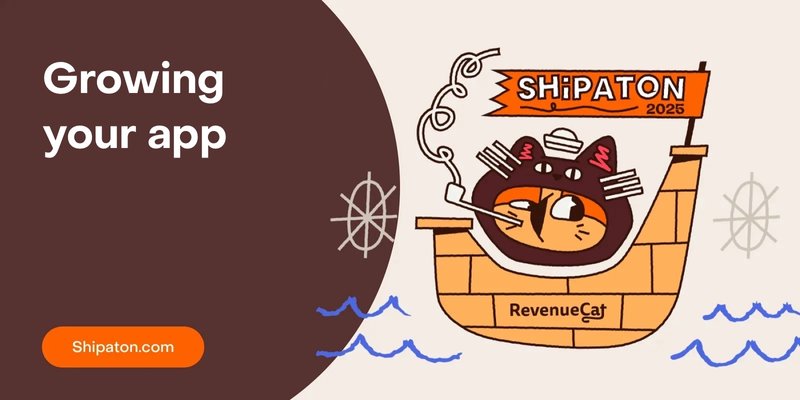You’ve come up with an app idea, you’ve built it, and now you need users to prove your app is growing. That’s how you win Shipaton. In this third, and second-to-last, installment of our “How to Win Shipaton” series, we’re diving into growth.
So far, we’ve covered how to generate an idea and turn it into a minimum lovable product without wasting time. By now, your app should be in the hands of users. Maybe it’s just TestFlight testers, or perhaps you’ve already launched on the App Store and gathered a small but loyal group giving feedback. Wherever you are, the next challenge is clear: it’s time to grow your user base.
In this guide, we’ll frame growth as momentum. Momentum builds as you listen to your users and strengthen your app’s presence. The milestone to aim for is 100 paying customers during Shipaton. It’s ambitious but realistic, and it doesn’t require gimmicky growth hacks to achieve.
Step 1: Acquire new users
The first step to growing your app is acquiring users. Your earliest users are usually the same people you spoke with when validating your idea — friends, family, or folks with the specific pain point you’re solving, like teachers. Now is the time to lean on those networks. Announce your app with a LinkedIn or Twitter post that clearly explains the problem you solve and why it matters. As you bring users in, keep track of who they are. You’ll want this list later when you start iterating or announcing updates.
The next step, once you’ve tapped your immediate circle, is finding new ones. Seek out niche communities on Reddit, Discord, or specialized forums where your potential users already gather. Don’t overlook small-scale influencers in your niche either. A micro-influencer with a few hundred engaged followers can often drive more adoption than a big account with a broad, unfocused audience. Offering them free access to your app in exchange for a shout-out can be a simple, low-cost win.
Shipaton is here to help
Shipaton itself is a powerful growth tool. Use the Shipaton Discord to showcase your app, gather feedback, and connect with other builders. Consider teaming up with fellow participants to cross-promote each other’s apps. Collaboration during Shipaton not only gets you more users, it also makes the experience more fun. Join IRL Shipaton events and ask people there to try your app.
Finally, make your first users feel like VIPs. Let them know how important they are to your app’s journey. You might offer an early-bird discount, unlock a custom “founding user” app icon, or create a playful Easter egg that only early adopters can access. These small touches not only reward loyalty but also turn users into advocates who bring in the next wave.
Step 2: Improve your discoverability
Every potential user passes through your App Store or Play Store product page. Making that page as strong and discoverable as possible is one of the clearest growth levers you have. With each release, revisit your title and description to make sure they include the keywords people actually use to search for apps like yours. This practice, App Store Optimization (ASO), can have a huge impact, and we’ve even put together a handy guide to help you get started.
Strong copy matters. Write an app description that clearly communicates your main features and, more importantly, the benefits users will get. Reinforce these benefits visually with well-designed screenshots and a short demo video that shows your app in action.
Ratings and reviews are another critical driver of visibility and conversion. Tap into that email list of early users and ask them directly for reviews. Make the ask personal and transparent: let them know honest feedback helps other people discover the app. Both Apple and Google reward well-rated apps by ranking them higher in search results and users will use it to determine if the app is worth trying.
Finally, keep your app fresh. Frequent small updates not only improve the product, they signal to the stores (and your users) that the app is actively maintained. And when you ship, be specific. Don’t do the generic “Bug fixes and performance improvements” update text. Instead, highlight the actual changes you’ve made, whether it’s new features, UI tweaks, or even minor improvements. This shows momentum and helps users see the progress you’re making.
Step 3: Keep existing users
Getting new users is important, but keeping the ones you already have is even more critical. In product development this is called retention, and it is where your app truly proves its value.
Start by responding to feedback quickly. If a user reports a bug or suggests an improvement, act on it and let them know as soon as you’ve made the change. This shows you’re listening and builds trust early. If they gave your app a bad rating in the app store because of a bug or missing feature, nudge them to try the new version where it’s fixed. It’s more than likely that they will fix their rating once they feel heard.
Show momentum by iterating visibly. Use your changelog and “What’s New” notes in the stores to highlight improvements, not just bug fixes. Small but frequent updates reassure users that the app is alive and getting better with every release.
Finally, engage on a personal level. A short direct message or email thanking early adopters can go a long way. When users feel recognized and valued, they’re more likely to stick around. It might make them also more likely to tell their friends about it.
Step 4: Build a feedback loop
Growth isn’t just about adding users, it’s about learning from the ones you already have. A strong feedback loop helps you figure out what’s working, what’s broken, and what to build next.
Start simple with lightweight questions. A quick “Was this feature useful?” or “How’s your experience so far?” can give you directional insights without overwhelming users. You can either do this by asking your users directly, or if you have time, implement a simple feedback feature in your app.
For more in depth conversations, set up channels outside the app. A short survey, or even better, a dedicated Discord or Slack group, gives your users a place to share thoughts, requests, and bugs in more detail. This kind of space also helps users feel closer to the product and the team behind it. Apps that have a strong user community around them are often some of the best monetizing apps.
Conclusion
Winning Shipaton isn’t just about hitting the biggest numbers. It’s about showing clear signs of growth and proving that you’ve hustled to get your app into more hands. Even small improvements, such a few new daily active users, a handful of signups, or the first batch of reviews, are what builds momentum. Track that progress, however modest it may be. The early metrics tell the story of an app that’s alive, growing, and moving in the right direction.
In the final part of this series, we’ll look at how to make your submission stand out. Beyond growth, it’s about telling your story in a way that shows the journey, the effort, and the vision behind your app. When we write that story into a Devpost submission we are going to use the growth methods you ended up using as story points.

